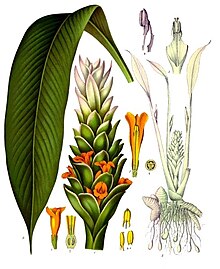
Back Kunyèt ACE Borrie Afrikaans Kurkuma ALS እርድ Amharic Curcuma longa AN كركم Arabic خرقوم ARY كركم ARZ হালধি Assamese Curcuma longa AST
| Turmeric | |
|---|---|

| |
| Inflorescence of Curcuma longa | |

| |
| Turmeric rhizome and powder | |
| Scientific classification | |
| Kingdom: | Plantae |
| Clade: | Tracheophytes |
| Clade: | Angiosperms |
| Clade: | Monocots |
| Clade: | Commelinids |
| Order: | Zingiberales |
| Family: | Zingiberaceae |
| Genus: | Curcuma |
| Species: | C. longa
|
| Binomial name | |
| Curcuma longa | |
| Synonyms | |
|
Curcuma domestica Valeton | |
Turmeric (/ˈtɜːrmərɪk, ˈtjuː-/),[2][3] or Curcuma longa (/ˈkɜːrkjʊmə ˈlɒŋɡə/),[4][5] is a flowering plant in the ginger family Zingiberaceae. It is a perennial, rhizomatous, herbaceous plant native to the Indian subcontinent and Southeast Asia that requires temperatures between 20 and 30 °C (68 and 86 °F) and high annual rainfall to thrive. Plants are gathered each year for their rhizomes, some for propagation in the following season and some for consumption.
The rhizomes are used fresh or boiled in water and dried, after which they are ground into a deep orange-yellow powder commonly used as a coloring and flavoring agent in many Asian cuisines, especially for curries, as well as for the dyeing characteristics imparted by the principal turmeric constituent, curcumin.[6]
Turmeric powder has a warm, bitter, black pepper-like flavor and earthy, mustard-like aroma.[7][8]
Curcumin, a bright yellow chemical produced by the turmeric plant, is approved as a food additive by the World Health Organization, European Parliament, and United States Food and Drug Administration.[6]
Although long used in Ayurvedic medicine, there is no high-quality clinical evidence that consuming turmeric or curcumin is effective for treating any disease.[9][10]

- ^ "Curcuma longa L." Plants of the World Online. Royal Botanic Gardens, Kew. Retrieved 26 March 2018.
- ^ "turmeric". Dictionary.com Unabridged (Online). n.d.
- ^ "turmeric". Merriam-Webster.com Dictionary. Merriam-Webster.
- ^ "curcuma". Dictionary.com Unabridged (Online). n.d.
- ^ "longa". Merriam-Webster.com Dictionary. Merriam-Webster.
- ^ a b Curcumin from PubChem
- ^ "Turmeric". Drugs.com. 2009. Retrieved 24 August 2017.
- ^ Brennan, J (15 October 2008). "Turmeric". The National.
- ^ Nelson, KM; Dahlin, JL; Bisson, J; et al. (2017). "The Essential Medicinal Chemistry of Curcumin: Miniperspective". Journal of Medicinal Chemistry. 60 (5): 1620–1637. doi:10.1021/acs.jmedchem.6b00975. PMC 5346970. PMID 28074653.
None of these studies [has] yet led to the approval of curcumin, curcuminoids, or turmeric as a therapeutic for any disease
- ^ "Turmeric". National Center for Complementary and Integrative Health, US National Institutes of Health. May 2020. Retrieved 25 November 2020.